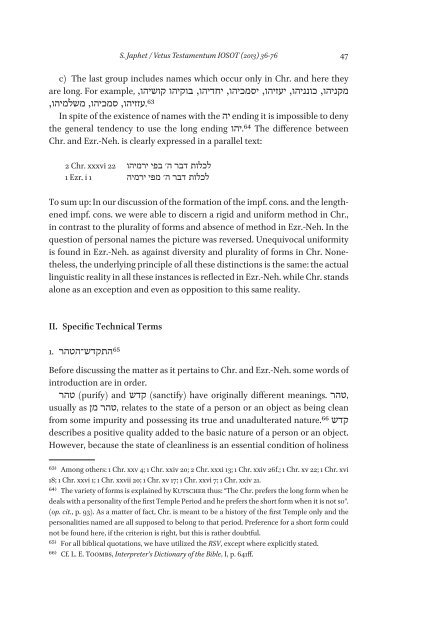Special Issue IOSOT 2013 - Books and Journals
Special Issue IOSOT 2013 - Books and Journals
Special Issue IOSOT 2013 - Books and Journals
You also want an ePaper? Increase the reach of your titles
YUMPU automatically turns print PDFs into web optimized ePapers that Google loves.
S. Japhet / Vetus Testamentum <strong>IOSOT</strong> (<strong>2013</strong>) 36-76 47<br />
c) The last group includes names which occur only in Chr. <strong>and</strong> here they<br />
מקניהו, כונניהו, יעזיהו, יסמכיהו, יחדיהו, בוקיהו קושיהו, example, are long. For<br />
63.עזזיהו, סמכיהו, משלמיהו,<br />
In spite of the existence of names with the יה ending it is impossible to deny<br />
the general tendency to use the long ending 64.יהו The difference between<br />
Chr. <strong>and</strong> Ezr.-Neh. is clearly expressed in a parallel text:<br />
2 Chr. xxxvi 22<br />
לכלות דבר ה׳ בפי ירמיהו 1 Ezr. i 1<br />
לכלות דבר ה׳ מפי ירמיה To sum up: In our discussion of the formation of the impf. cons. <strong>and</strong> the lengthened<br />
impf. cons. we were able to discern a rigid <strong>and</strong> uniform method in Chr.,<br />
in contrast to the plurality of forms <strong>and</strong> absence of method in Ezr.-Neh. In the<br />
question of personal names the picture was reversed. Unequivocal uniformity<br />
is found in Ezr.-Neh. as against diversity <strong>and</strong> plurality of forms in Chr. Nonetheless,<br />
the underlying principle of all these distinctions is the same: the actual<br />
linguistic reality in all these instances is reflected in Ezr.-Neh. while Chr. st<strong>and</strong>s<br />
alone as an exception <strong>and</strong> even as opposition to this same reality.<br />
II. Specific Technical Terms<br />
65 התקדש־הטהר 1.<br />
Before discussing the matter as it pertains to Chr. <strong>and</strong> Ezr.-Neh. some words of<br />
introduction are in order.<br />
,טהר meanings. (sanctify) have originally different קדש (purify) <strong>and</strong> טהר<br />
usually as מן ,טהר relates to the state of a person or an object as being clean<br />
קדש nature.66 from some impurity <strong>and</strong> possessing its true <strong>and</strong> unadulterated<br />
describes a positive quality added to the basic nature of a person or an object.<br />
However, because the state of cleanliness is an essential condition of holiness<br />
63) Among others: 1 Chr. xxv 4; 1 Chr. xxiv 20; 2 Chr. xxxi 13; 1 Chr. xxiv 26f.; 1 Chr. xv 22; 1 Chr. xvi<br />
18; 1 Chr. xxvi 1; 1 Chr. xxvii 20; 1 Chr. xv 17; 1 Chr. xxvi 7; 1 Chr. xxiv 21.<br />
64) The variety of forms is explained by Kutscher thus: “The Chr. prefers the long form when he<br />
deals with a personality of the first Temple Period <strong>and</strong> he prefers the short form when it is not so”.<br />
(op. cit., p. 93). As a matter of fact, Chr. is meant to be a history of the first Temple only <strong>and</strong> the<br />
personalities named are all supposed to belong to that period. Preference for a short form could<br />
not be found here, if the criterion is right, but this is rather doubtful.<br />
65) For all biblical quotations, we have utilized the RSV, except where explicitly stated.<br />
66) Cf. L. E. Toombs, Interpreter’s Dictionary of the Bible, I, p. 641ff.








![Am HaSefer [Volk des Buches] - Books and Journals](https://img.yumpu.com/20648352/1/174x260/am-hasefer-volk-des-buches-books-and-journals.jpg?quality=85)







